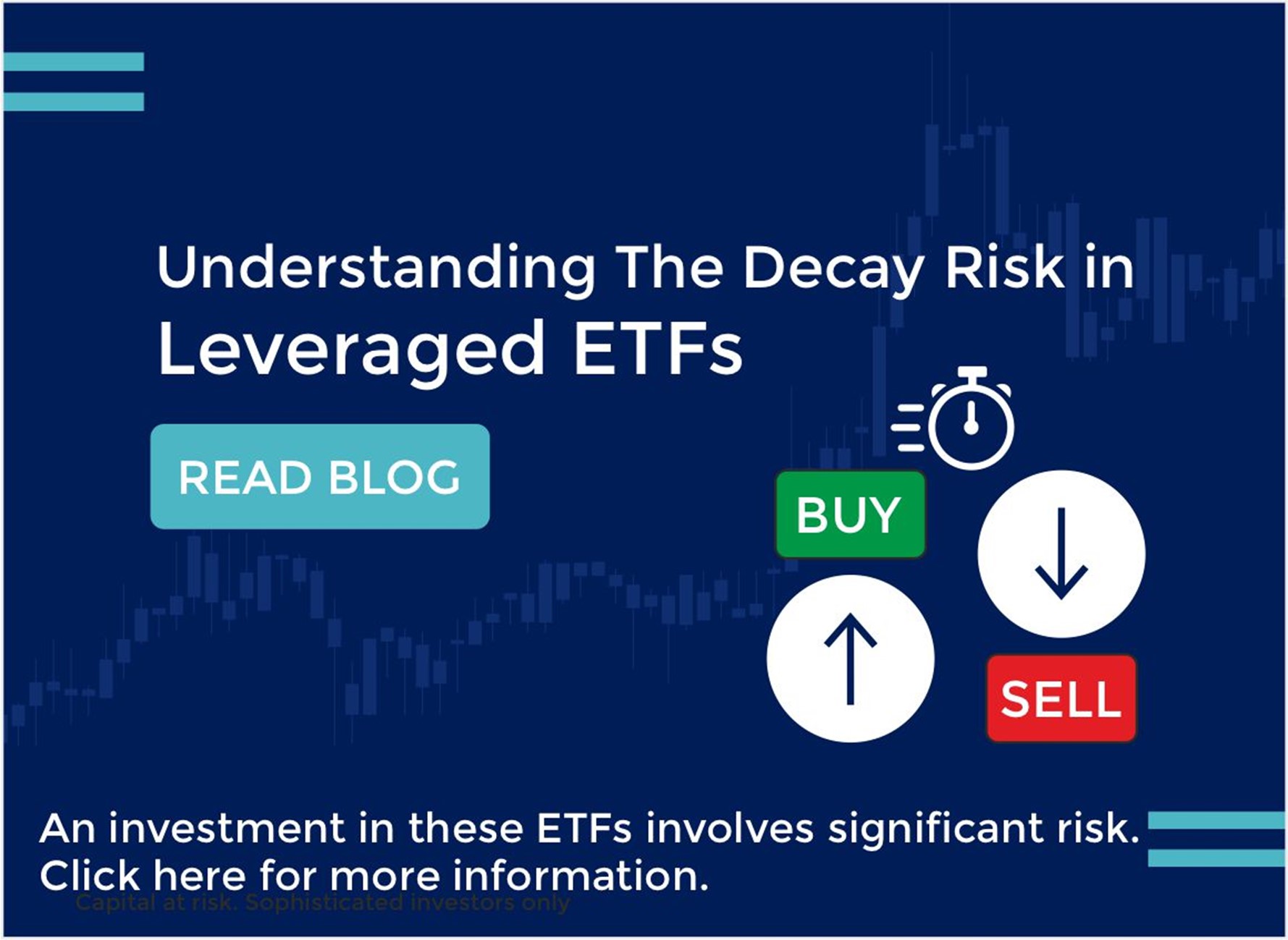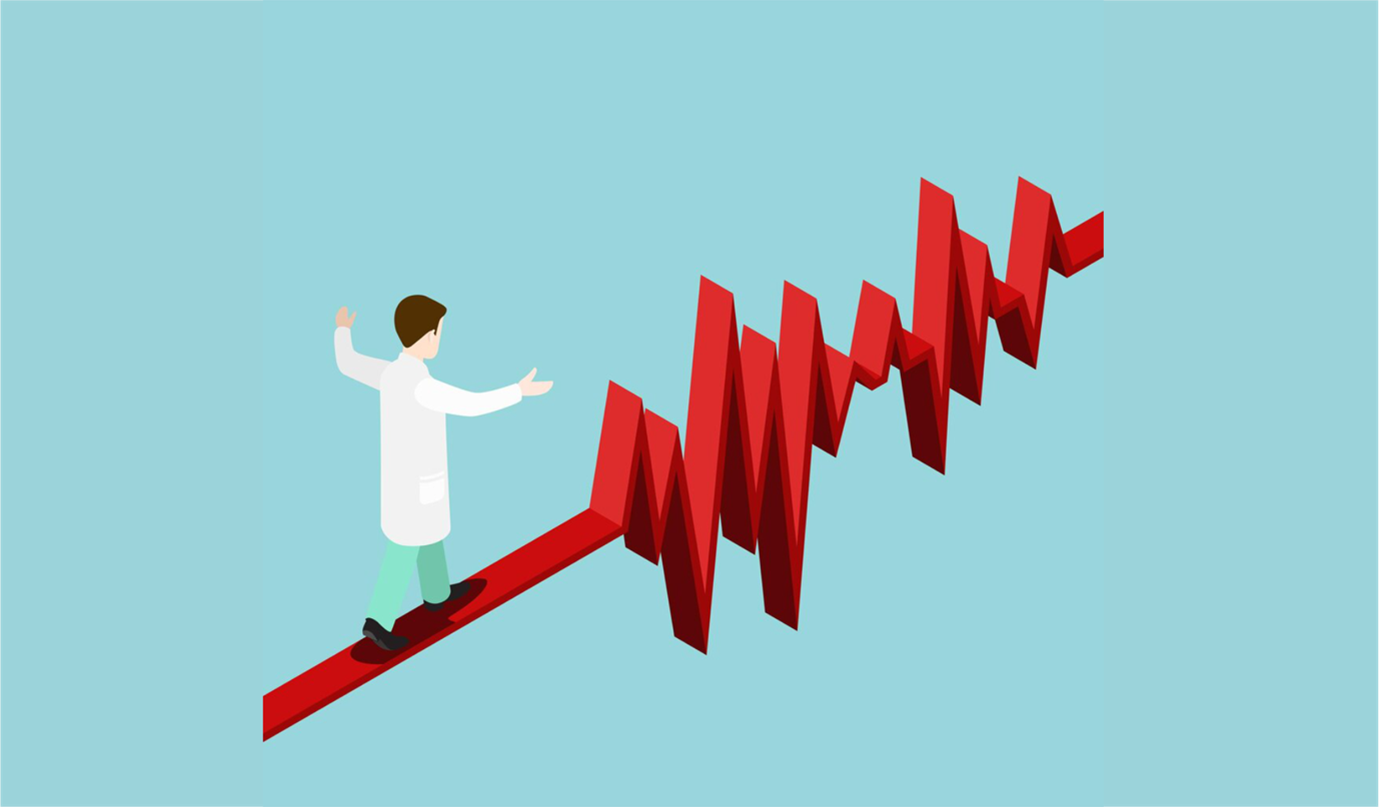Understanding The Decay Risk in Leveraged ETFs
Posted:
Leveraged ETFs can be a valuable tool for experienced investors looking to amplify returns in a short-term window. However, there are plenty of risks associated with these ETFs. Because of this, it’s important to understand these potential pitfalls and develop a sound exit strategy when dealing with these funds.
One of the risks surrounding these ETFs comes in the form of decay risk. This happens when the performance of the leveraged ETF moves (or drifts) away from the underlying asset over time.
But why does this occur? Below, we’ll run through everything you need to know to understand the decay risk in leveraged ETFs while running through some examples on how this process works.
When it comes to leveraged ETFs, it’s very important to understand the decay risk.
Why Do Leveraged ETFs Decay?

Leveraged ETFs are designed to multiply the daily returns of an underlying index. For example, a 2x leveraged ETF is set to double the daily performance of the asset it’s tied to. If the underlying asset increases by 1% that day, then the 2x leveraged ETF increases by 2%. If the asset increases by 3.5%, then the 2x leveraged ETF increases by 7%.
The inverse is also true in these situations. If the underlying asset drops by 2% in a day, then the 2x leveraged ETF drops by 4%.
It’s important to remember that gains and losses are compounded daily. After each day, the leveraged ETF is reset and calibrated back to the underlying asset. Due to this, the leveraged ETF can move away from the true performance of the underlying asset over time.
These daily resets can sometimes compound losses in certain market conditions and time horizons. In other words, several bad days in a row can lead to significant losses even if the underlying asset remains somewhat stable over time.
The example below can further demonstrate the decay effect associated with these ETFs.
Examples of Decay
For example, let’s consider this hypothetical example with GraniteShares 2x Long AAPL Daily ETF. This fund, designated by the ticker AAPB, tracks the performance of Apple’s stock and doubles the daily returns or losses of that asset.
If Apple’s stock goes up by 5% over a span of two weeks, we would expect AAPB, the 2x leveraged ETF, to be at 10%. However, due to decay, the actual return could be less than 10%.
That’s because of daily rebalancing. Speaking for the sake of this example, let’s say the following played out within those two weeks: there were days when AAPL went up by 2% and others when it fell by 2-3%. The 2x Long AAPL Daily ETF was reset after each of those days, which led to a subtle drift away from the performance of the underlying stock.
Decay becomes more prominent the longer you hold a leveraged ETF. While the effects of it may be minimal in the short term, it can compound overtime and lead to an unexpected deviation from the underlying asset.
In the previous example, you can imagine what the decay effect looks like when holding the leveraged ETF for a year or so.
Long-Term Holding of Leveraged ETFs

Leveraged ETFs are primarily used for short-term trading opportunities. Investors usually hold these funds for a day or two, sometimes up to 10-14 days on the longer side. In other words, these leveraged ETFs are not intended to be held for months or years on end.
The decay risk is a substantial reason for this, as the performance of the these ETFs can drift away from the underlying asset over time. Time decay starts to compound and become more noticeable the longer you hold onto an asset.
For instance, the decay incurred over a year of holding a leveraged ETF is much more noticeable (and carries more risk) than what an investor would experience in a week.
Managing Decay Risk
As mentioned above, one of the best ways to manage decay risk is by considering the time frame you are holding the leveraged ETF. Keep in mind that these funds are meant to be traded in short-term windows. The longer you hold the fund beyond a couple of days or weeks, the decay risk starts to creep in.
That’s why it’s important to have clear targets for entry and exit points before investing in a leveraged ETF. Consider the reduced time horizon when developing a strategy and pricing targets for a potential short term move.
On top of that, frequent monitoring of your position is recommended. Situations can evolve rapidly, especially in volatile markets, so it’s best to keep a watchful eye over your investments and act accordingly.
Assessing Risk Tolerance

When looking at leveraged ETFs, it’s important for investors to weigh the potential for higher returns with the risks associated. Time decay is one of those risks, especially when you hold a leveraged ETF in a longer-term setting.
Decay occurs due to daily rebalancing and it can have a compound effect over time. Because of this, leveraged ETFs are primarily used as short-term investment strategies by experienced traders that fully understand the risks associated with these funds.
On top of that, it’s important to monitor your leveraged ETF positions frequently and adjust to any changes. Accurately assessing your risk tolerance, experience level, position sizing, and entry/exit points are all crucial elements to consider before getting started with leveraged ETFs.
You can view a full list of GraniteShares leveraged ETFs, which includes funds tied to popular single stocks like Amazon, Tesla, Apple, Nvidia, Microsoft, Coinbase, and more.
ETFs by GraniteShares
| Product name | Ticker |
|---|---|
| US | |
Important Information
Investors should consider the investment objectives, risks, charges and expenses carefully before investing. For a prospectus or summary prospectus with this and other information about the Funds, please call (844) 476 8747 or visit www.graniteshares.com. Read the prospectus or summary prospectus carefully before investing.
The investment program of the funds is speculative, entails substantial risks and include asset classes and investment techniques not employed by more traditional mutual funds.
PRINCIPAL FUND RISKS (see the Prospectus for more information)
The Fund is not suitable for all investors. The investment program of the funds is speculative, entails substantial risks and includes asset classes and investment techniques not employed by most other ETFs and mutual funds. Investments in the ETFs are not bank deposits and are not insured or guaranteed by the Federal Deposit Insurance Corporation or any other government agency. The Fund is designed to be utilized only by knowledgeable investors who understand the potential consequences of seeking daily leveraged (2X) investment results, understand the risks associated with the use of leveraged exposure and are willing to monitor their portfolios frequently. For periods longer than a single day, the Fund will lose money if the Underlying Stock’s performance is flat, and it is possible that the Fund will lose money even if the Underlying Stock’s performance leveraged over a period longer than a single day. An investor could lose the full principal value of his/her investment within a single day.
The Fund seeks daily leveraged investment results and are intended to be used as short-term trading vehicles. This Fund attempts to provide daily investment results that correspond to the respective leveraged of the performance of its underlying stock (a leveraged Fund).
Investors should note that the fund pursues daily leveraged investment objectives, which means that the fund is riskier than alternatives that do not use leverage because the fund magnifies the performance of their underlying security. The volatility of the underlying security may affect a Fund’s return as much as, or more than, the return of the underlying security.
Because of daily rebalancing and the compounding of each day’s return over time, the return of the Fund for periods longer than a single day will be the result of each day’s returns compounded over the period, which will very likely differ from 200% of the return of the Underlying Stock over the same period. The Fund will lose money if the Underlying Stock’s performance is flat over time, and as a result of daily rebalancing, the Underlying Stock volatility and the effects of compounding, it is even possible that the Fund will lose money over time while the Underlying Stock's performance increases over a period longer than a single day.
An investment in the Fund involves risk, including the possible loss of principal. The Fund is non-diversified and includes risks associated with the Fund concentrating its investments in a particular industry, sector, or geographic region which can result in increased volatility. The use of derivatives such as futures contracts and swaps are subject to market risks that may cause their price to fluctuate over time. Risks of the Fund include effects of Compounding and Market Volatility Risk, Inverse Risk, Market Risk, Counterparty Risk, Rebalancing Risk, Intra-Day Investment Risk, Daily Index Correlation Risk, Other Investment Companies (including ETFs) Risk, and risks specific to the securities of the Underlying Stock and the sector in which it operates. These and other risks can be found in the prospectus.
This information is not an offer to sell or a solicitation of an offer to buy shares of any Funds to any person in any jurisdiction in which an offer, solicitation, purchase or sale would be unlawful under the securities laws of such jurisdiction.
THE FUNDS AREDISTRIBUTED BY ALPS DISTRIBIUTORS, INC. GRANITESHRES IS NOT AFFILIATED WITH ALPS DISTRIBUTORS, INC


